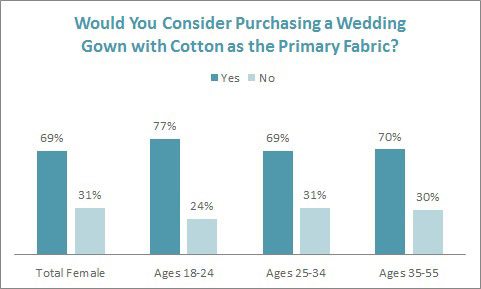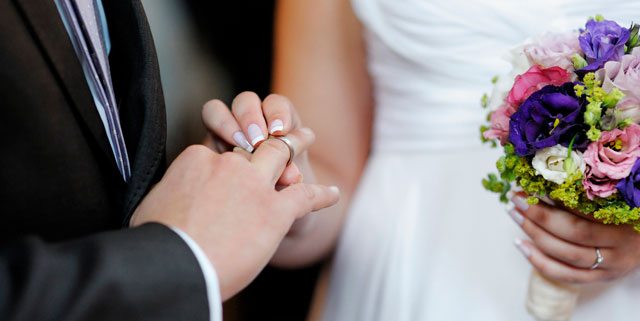Embellishments and advances in fabric treatments have designers insisting a cotton gown is not just for beach weddings, but can be anything the bride wishes: breezy, vintage, formal…and definitely beyond strapless.
Bridal designer Faith Thornburg says the many available cotton or cotton blend fabrics allow for any style to take shape.
[quote]”Some really beautiful cotton fabrics can be light and airy like an organza or, vice versa, they can have a crisp look,” Thornburg says. “Cotton lace is one of my favorites. It’s just as beautiful as a lot of the silk laces and creates a romantic style.”
Currently, 58% of women say they prefer a silk bridal gown, according to the Cotton Incorporated Lifestyle Monitor™ Survey. However, nearly 70% would consider purchasing a gown with cotton as the primary fabric. Among these women, almost one‐third (32%) would do so for comfort, followed by “looks good” (24%), breathability (10%) and fit (9%).
Designer Claire Pettibone, who says she does not have a single strapless gown in her collection, is known for her ethereal cotton gowns.
“Cotton does lend itself to endless variations of outdoor, rustic, organic, garden settings, and the added draw of being comfortable and breathable does appeal to brides with weddings in these types of venues,” Pettibone says. “I wouldn’t say cotton is necessarily less formal, but for my collection, I do see it as having a vintage quality, as opposed to a very modern, architectural feeling.”
One of the “vintage” looks that is growing rapidly includes the sleeved gown, which England’s Kate Middleton brought to the fore when she married Prince William two years ago. That dress, designed by Sarah Burton for Alexander McQueen, featured a floral lace bodice, deep V-neck, high lace collar and long lace sleeves. Against a sea of strapless, sleeveless style that enjoyed a solid, 10-year run, the unapologetic traditional styling of Kate’s gown made it instantly novel.
Inside Weddings’ Martine Aerts-Niddam, creative director, fashion and beauty, says Kate’s dress was influential — and the industry is also experiencing a natural evolution.
“The consumers and the buyers want to see new things in stores,” Aerts-Niddam explains. “The marketplace is changing to have cap, elbow and long sleeves for this fall/winter. And designers are being successful with it. Long sleeves are usually illusion sleeves that keep it easy and airy — not difficult and warm.”
Designer Gemy Malouf says today’s brides love embellishments on the shoulders, around the neck or even on the sleeves.
“In this season’s cotton dresses, I have a décolleté dress with the one-shoulder embellished strap, while the second dress has lace covering the shoulder and going around the neck,” Malouf says.
Whatever style women choose, these days they are willing to pay about $809 for the “perfect” wedding gown, according to the Monitor. It is just one item on the to-do list for a couple’s big day, which on average costs $25,656, according to The Wedding Report.
Weddings are a $53.4 billion industry in the U.S., due in part to the popularity of the destination wedding. A recent survey from the XO Group Inc., creator of TheKnot.com and WeddingChannel.com, revealed 24% of couples get hitched during a destination wedding. But celebrations overall are becoming more casual, with 17% of brides saying they prefer less formal style. Those who describe their weddings as “elegant” fell from 31% in 2008 to 22% in 2012.
“Of course cotton is wonderful for a beach wedding, but I don’t usually have that in mind when working with this fabric,” Pettibone says. “It’s more of a soft, romantic mood that can be wonderful in many settings. Cotton is used in lace, combined with other fibers, and there are many different finishes and weights that all have very different looks, from casual to formal.”
Malouf says proper finishing helps create a radiant cotton gown for any wedding concept. “Embroidering the piece with crystals or beads, embellishing it with a quality lace and inserting horse ribbon onto the hem — all these elements give the dress glorious shapes and magnificent looks.”
 Brides say the most important feature in their gowns is the fit (94%), Monitor data show, followed by style (93%), price (89%), and comfort (88%).
Brides say the most important feature in their gowns is the fit (94%), Monitor data show, followed by style (93%), price (89%), and comfort (88%).
New designer Jean-Ralph Thurin says today’s brides base their gown choice on style, but those that are all or partially made of cotton have an added plus.
“There have been many innovations made to cotton fabrics that have added dimensional details, like intricate weaves and surface treatments,” Thurin says. “Beading, embroidery and lace treatments added to cotton are particularly beautiful because they add elements of sophistication.”
Thornburg says with all the cotton blend fabrics out there, a bride could easily create a gown for any occasion.
“Going to your local fabric store won’t do the trick in this case,” she says. “However, finding beautiful cotton organza, lace, etcetera, allows for a beautiful beach wedding style or a great formal wedding style. The sky is the limit as long as you’re creative enough.”
